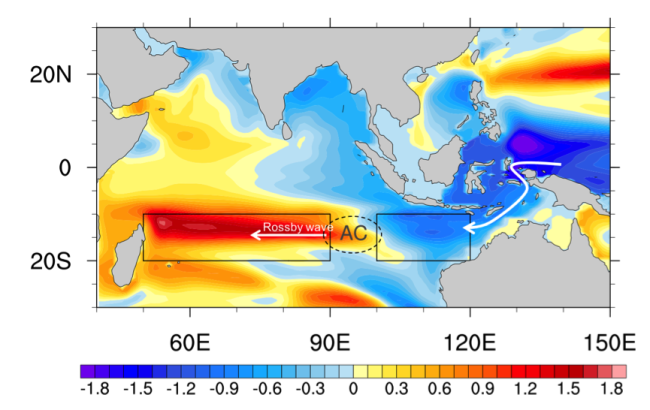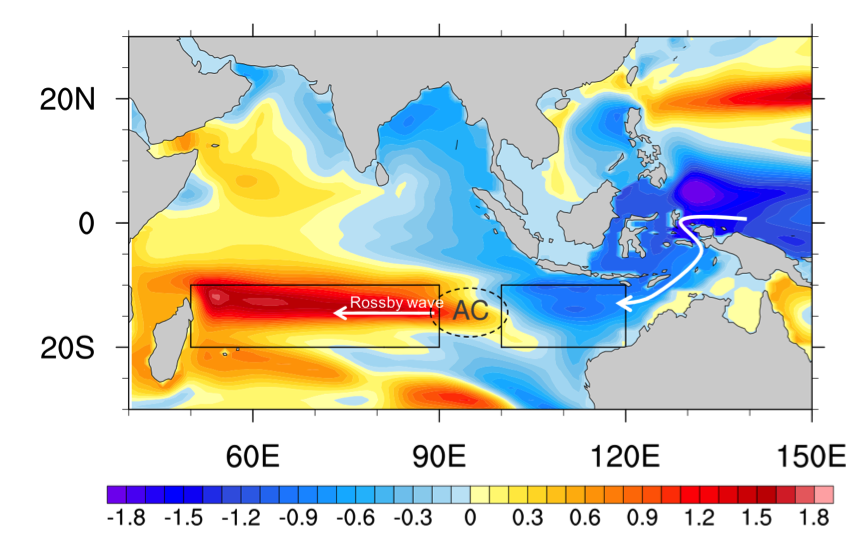Pacific influences decadal Indian Ocean heat content via two distinct mechanisms
Since the early 2000s, the Indian Ocean has displayed an anomalous surface warming and an accelerated increase in the ocean heat content below 50 m, concurrent with a cooling of the upper 700 m layer in the Pacific. This heat redistribution in the Indo-Pacific region has been linked to enhanced heat transport from the Pacific to the Indian Ocean via the Indonesian Throughflow. Changes in Indian Ocean heat content accounted for a large fraction of global ocean heat gain in the upper 700 m post-2000, leading to increasing recognition of the important role of the Indian Ocean in modulating global climate variability.


In two recent papers published in the Journal of Climate, Jin and coauthors investigated how decadal variations of subsurface ocean heat content (50–300 m) in the Indian Ocean respond to conditions in the Pacific region. Using ocean reanalyses, they identified a pronounced east–west dipole structure in the southern tropical Indian Ocean and linked it to discontinuities in westward-propagating signals in the central Indian Ocean (around 100° E). What this suggests is that conditions in the Pacific influence subsurface ocean heat content in the eastern and western parts of the Indian Ocean via distinct mechanisms on decadal timescales. Decadal variations of ocean heat content in the eastern Indian Ocean are attributed to surface wind anomalies in the western Pacific, which trigger oceanic Rossby waves that propagate westward through the Indonesian seas and influence heat transport in the Indonesian Throughflow. Decadal variations of ocean heat content in the western Indian Ocean are linked to conditions in the Pacific via changes in the atmospheric Walker cell, which trigger anomalous wind stress curl and Ekman pumping in the central tropical Indian Ocean. Westward-propagating oceanic Rossby waves then extend the influence of this anomalous Ekman pumping to the western Indian Ocean. These mechanisms have been further investigated in a hierarchy of models, including a theoretical model, ocean general circulation model experiments, and coupled model experiments.
These results provide a new perspective for understanding the influence of the Pacific on Indian Ocean decadal variability, suggesting that the western and eastern parts of the Indian Ocean respond to the tropical Pacific in distinct ways on decadal timescales. Given mounting observational and modeling evidence that Indian Ocean decadal variations have large climate impacts both regionally and globally, these two studies have implications for decadal climate predictions in the tropical Indian Ocean and surrounding countries.
Influences of Pacific Climate Variability on Decadal Subsurface Ocean Heat Content Variations in the Indian Ocean (J. Climate)
Xiaolin Jin1, Young-Oh Kwon2, Caroline C. Ummenhofer2, Hyodae Seo2, Franziska U. Schwarzkopf3, Arne Biastoch3, Claus W. Böning3, and Jonathon S. Wright1
1Tsinghua University, China
2Woods Hole Oceanographic Institution
3GEOMAR Helmholtz Centre for Ocean Research Kiel, Germany
Xiaolin Jin1, Young-Oh Kwon2, Caroline C. Ummenhofer2, Hyodae Seo2, Yu Kosaka3, and Jonathon S. Wright1
1Tsinghua University, China
2Woods Hole Oceanographic Institution
3The University of Tokyo, Japan
Topics
- Pacific Ocean
- Ocean Heat
- Modeling
- Air-Sea
- Indian Ocean
